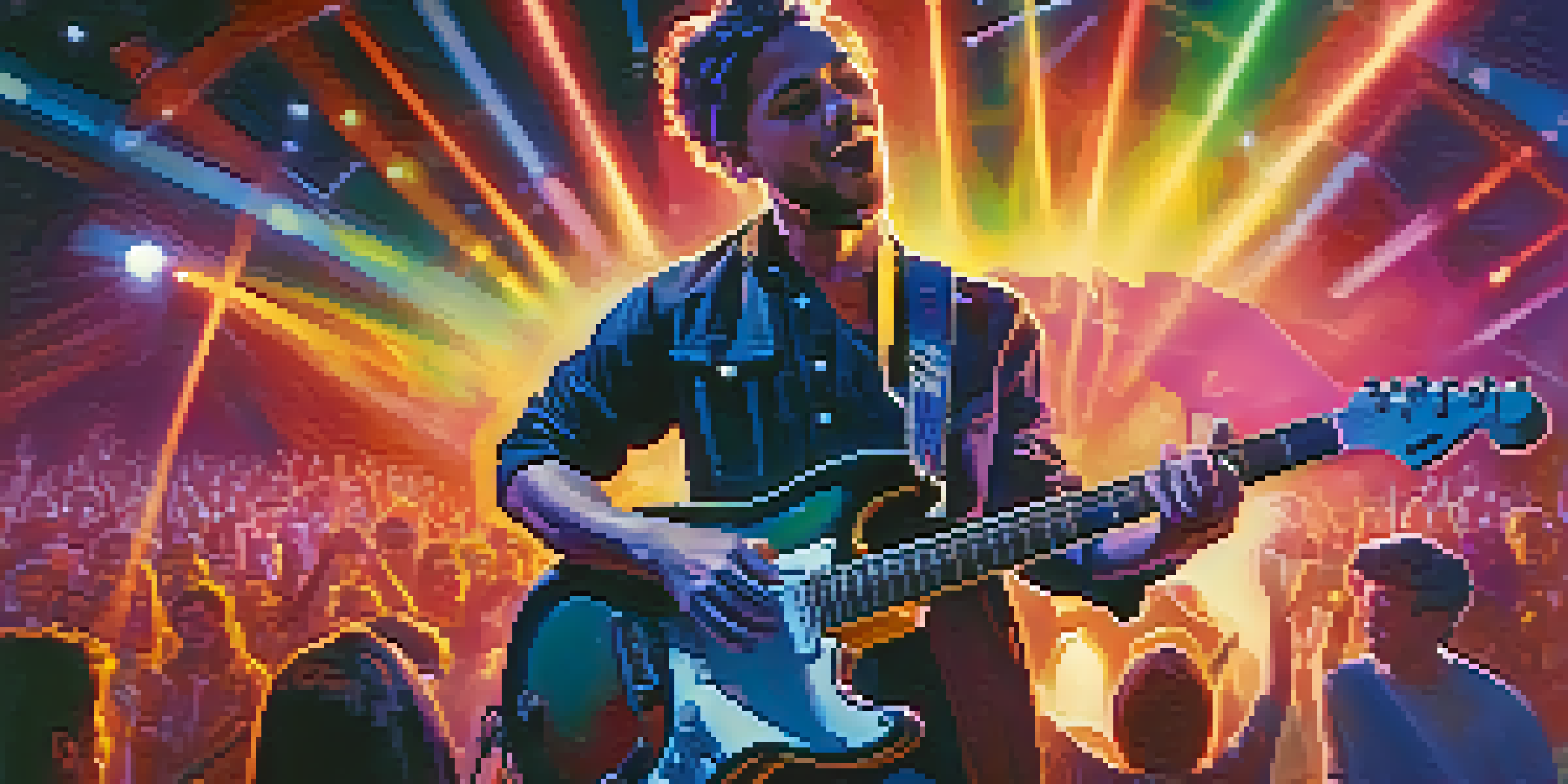Building Stage Presence: Captivating Your Audience with Guitar

Understanding the Importance of Stage Presence
Stage presence is the magnetic quality that draws your audience in, making them feel connected to your performance. It’s not just about how well you play; it’s about how you make your audience feel. A captivating stage presence can transform a simple song into an unforgettable experience.
The most important thing is to enjoy your life—to be happy—it's all that matters.
Think of stage presence as the invisible thread that links you to your listeners. When you exude confidence and passion, it resonates with your audience, creating a shared emotional journey. This connection is what keeps them engaged and wanting more.
Consider some of the greats—like Jimi Hendrix or Freddie Mercury. Their performances weren’t just about the music; it was their vibrant energy and charisma that left a lasting impression. Learning to cultivate your own stage presence can elevate your performances to new heights.
Body Language: Conveying Emotion Through Movement
Your body language plays a crucial role in how your audience perceives your performance. Simple gestures, facial expressions, and even your posture can convey emotions and stories that words often cannot. Being aware of your physical presence can enhance the overall experience.

For instance, when you strum a powerful chord, lean into it, or when you play a tender melody, soften your posture to reflect that emotion. These subtle cues help to communicate the feelings behind your music, making it more relatable to your audience.
Stage Presence Connects with Audience
A captivating stage presence draws in the audience, making them feel a shared emotional connection to the performance.
Practice in front of a mirror or record yourself to see how your body language comes across. You might be surprised at how much non-verbal communication influences the energy in the room!
Engaging Your Audience: The Power of Eye Contact
Making eye contact with your audience is a powerful way to create a connection. It can make listeners feel acknowledged and involved in your performance, turning a passive experience into an interactive one. This simple act can elevate your stage presence significantly.
Music can change the world because it can change people.
Imagine playing to a sea of faces, and instead of looking down at your guitar, you scan the crowd, locking eyes with different people. You’ll notice their reactions, and this can inspire your performance, creating a dynamic feedback loop between you and your audience.
Eye contact can be a bit intimidating at first, but start small. Focus on a few friendly faces in the crowd, then gradually widen your gaze. You'll find that this connection can fuel your energy and confidence on stage.
Creating a Strong Opening: Set the Tone
The first moments of your performance are crucial—they set the tone for the entire show. A strong opening not only grabs attention but also establishes your presence as a confident performer. Whether it’s a powerful riff or a captivating story, make those first moments memorable.
Consider starting with a bold instrumental piece or an engaging anecdote about the song you’re about to play. This primes your audience, drawing them into your world and making them eager to hear what comes next.
Body Language Enhances Performance
Your body language conveys emotions and stories that can elevate the overall experience for your listeners.
Remember, the energy you bring at the beginning can influence the audience’s mood for the rest of the set. So, invest time in crafting an opening that reflects your personality and musical style.
Storytelling: Weaving Narratives into Your Music
Every song has a story, and sharing these narratives with your audience can deepen their connection to your music. Whether it’s personal experiences or universal themes, storytelling adds layers of meaning that resonate with listeners. This is where your authenticity shines.
For example, before performing a heartfelt ballad, you might share a brief story about its inspiration. This not only engages the audience but also gives them a glimpse into your creative process, making the experience more intimate.
Effective storytelling can transform a performance into a shared experience, allowing the audience to feel like they are part of your journey. So, don’t shy away from sharing your stories—they can be just as captivating as your music.
Adapting to Your Audience: Reading the Room
Being able to read your audience is an invaluable skill for any performer. Each crowd is different, and their reactions can vary widely. By paying attention to their energy and engagement, you can adapt your performance to better suit their vibe.
For instance, if you notice your audience is more energetic, you might want to play faster tempos or more upbeat songs. Conversely, if they seem more subdued, opt for softer melodies or storytelling to draw them in.
Engage Through Eye Contact
Making eye contact with the audience fosters an interactive experience, enhancing your connection and energy on stage.
This adaptability not only enhances the performance but also shows your audience that you’re attuned to their responses. Remember, a great performer is not only a skilled musician but also a keen observer.
Practice Makes Perfect: Rehearsing for Stage Presence
Like any skill, developing stage presence takes practice. Regular rehearsals provide the opportunity to refine your performance, experiment with different techniques, and build confidence. The more comfortable you are on stage, the more natural your presence will become.
Try practicing in front of friends or family who can give you constructive feedback. Alternatively, consider recording your rehearsals to review how your body language, eye contact, and overall energy come across.

Remember, every rehearsal is a chance to grow. Embrace the process and be open to evolving your stage presence until it feels authentic and captivating.